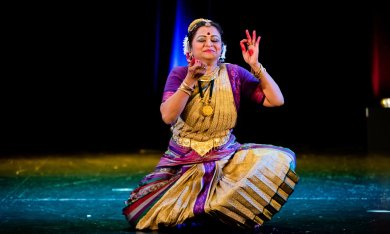
|   |

|   |
Rasanubhava: An art experience - Archana Vyasam e-mail: vvnarchana@gmail.com October 25, 2019 Sindhubhairavi Centre for Indian Arts and Culture presented Rasanubhava - The art experience, on October 13, 2019. Leaving the Rasanubhava for later, what went through this three hour evening was in itself a subtle statement of what can be showcased to the audience if the artist is well informed and equipped. It is quite heartening to note that in the sports capital of Australia, Melbourne, where this generation which finds it hard to enjoy a Test match or one day with 50 overs which paved way to 20/20, its Indian diaspora that learns art witnessed patiently, a three plus hour Bharatanatyam program. The moment I saw the young dancers on stage all set to invoke the blessings of Ganesha through the lyrics of Oothukadu Venkata Subbaiyer in Gambhira Nata, I was preparing for the usual items showcased or packaged with different names. It was when the tiniest tots of Chandana Brijesh's institute Sindhubhairavi came on stage in their Bharatanatyam make-up and costume and started their Asamyutha Hasthas or Single Hand gestures, I took to my seat with curiosity. The little ones rendering the shloka with a few senior students taking over to give the layam for their recitation in the 4 beat tala was refreshing. The same item was bi-sectioned and the latter one had the slightly bigger kids split as the nattuvanars or thattuvanars (on the lighter side) as they were clapping the 5 different beats to which the dancers demonstrated the Pancha Nadais or the 5 types of basic rhythmic walks. It was a very effective expression where laya brings forth to the sahrudaya that performance at each one's ability varies but the base is the same. To top it, I felt this piece could perhaps defy the popular shloka from Sangeetha Sashtram, "Geetham vadhyam thatha nrityam thrayam sangeetham ucchyathe" which implies music and dance are incomplete without each other, because this piece brought out the nuances of talam, aharyam (the enhancement gotten from the make-up and costume), the importance of theory that forms the grammar of dance and the spot on entries and exits that makes one note what it takes to make any form a fine art. Next was an unexpected twist with the advent of mothers with their Bhakti Shakti. Many thoughts engulfed as the moms of the students attempted Nagendra Haraya. Was it the power of Shakti which is them - the women - the mother that has been eulogised until a week back on the eve of Navaratri who had such deep commitment to themselves to give all they could for learning this art or the power of bhakti towards the art that chiselled poise in them while they transitioned through the Na Ma Shi Va Ya of the Shiva Panchakshara Stotram? Be it whichever power, the ending note of the item was impactful as each mother's ward joined them as their respective Shiva sensitising them and us to empathise what goes to learning a classical art form and also leaving us wishing everyone could see the god in the child. The knowledge of an informed dancer like Chandana helped kindle all the basics, warming up the audience for the visual treat to unfold in the second half of the evening. Chandana's portrayal of Adi Shankaracharya's Guru Vandana was simple establishing the fact that guru-sishya parampara is simple when approached with complete surrender. In accompaniment were Uthra Vijay on vocals and Sheshadri Varadarajan on veena.  Dr. Padmaja Suresh Padmaja then presented Devi portraying the divinity of the goddess in a human form expressing the nine sentiments or the navarasas. An excerpt of Adi Shankaracharya's Soundarya Lahiri, "Shri Chakraraja," a unique composition that glorifies the Devi as seated in the mystical spot, 'Bindu' of the Sri Chakra which is a representation of the Universe, was followed by Ardhanareeshwara by Muthuswami Dikshitar in Kumudakriya with the beginning verses by Mahakavi Kalidasa portraying the magnificence of the confluence of the masculine and feminine principles. Throughout her performance, her fluidity in expressions, control in her movements both in nritta and abhinaya and a distinct delivery of vallinam (power) and mellinam (grace) was noteworthy. A well put together souvenir was released and given to all the attendees. It was wonderful to take home a return gift that was a repository of insightful and thought provoking articles penned by Dr. Padmaja Suresh and eminent artistes, Kriya instructors, Indologists and doctors of Melbourne paving way to a research oriented outlook to arts, science and philosophy. For an art enthusiast though, experiencing rasa undivided or unaffected seemed elusive owing to the cries of the toddlers, desperation of the sponsors to market themselves and compelling the artists to place their presentations in the prime time. This did hinder the flow of rasa, making us want patrons to be like the ones from the past who dedicatedly worked and contributed for the flourishment of arts. However, artists of this generation do have the resilience to hold on and establish the link to evoke rasa which is any art or artist's prime objective. And Renaissance Theatre was an apt choice. Archana, a Kalakshetra alumna, is Artistic Director of Manjeeram Academy of Fine Arts (Hyderabad and Melbourne) that works on life skills through dance. She is a freelance writer on the Arts. |